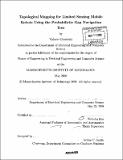Topological mapping for limited sensing mobile robots using the Probabilistic Gap Navigation Tree
Author(s)
Gordeski, Valerie
DownloadFull printable version (20.70Mb)
Other Contributors
Massachusetts Institute of Technology. Dept. of Electrical Engineering and Computer Science.
Advisor
Nicholas Roy.
Terms of use
Metadata
Show full item recordAbstract
This thesis proposes a novel structure for robotic navigation with minimal sensing abilities called the Probabilistic Gap Navigation Tree (PGNT). In this navigation approach, we create a topological map of the environment based on a previously created Gap Navigation Tree (GNT) [40]. The "gap" in the gap navigation algorithm represents a discontinuity in the robotic field of vision. The robot is able to use the gaps to represent its world as a tree structure (GNT), in which each vertex corresponds to a gap. Ideally, the robot navigates in the world by following the tree branches to its desired goal. However, due to the sensor uncertainty, the robot may detect discontinuities when there are none present, and vice versa. The Probabilistic Gap Navigation Tree compensates for the measurement noise by sampling from a distribution of the gap navigation trees to obtain the most likely tree given the sensor measurements, similar to the particle filtering algorithm used in Monte Carlo localization. Therefore, the PGNT allows navigation in an unknown environment using a realistic range finder, as opposed to the ideal sensor model assumed previously. We demonstrate the ability to build a PGNT in a simulated environment.
Description
Thesis (M. Eng.)--Massachusetts Institute of Technology, Dept. of Electrical Engineering and Computer Science, 2008. Includes bibliographical references (p. 75-78).
Date issued
2008Department
Massachusetts Institute of Technology. Department of Electrical Engineering and Computer SciencePublisher
Massachusetts Institute of Technology
Keywords
Electrical Engineering and Computer Science.